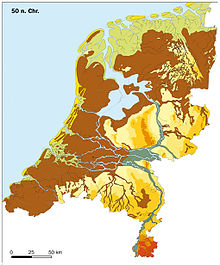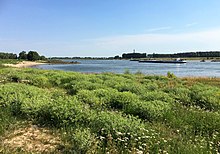Batavia(/bəˈteɪviə/;Dutch:Betuwe,Dutch:[ˈbeːty.və]) is a historical and geographical region in theNetherlands,forming large fertile islands in theriver deltaformed by the waters of theRhine(Dutch:Rijn) andMeuse(Dutch:Maas) rivers. During theRoman Empire,it was an important frontier region and source of imperial soldiers. Its name is possibly pre-Roman.
 TheNetherlandsc. 50 CE.The river islands, one of which was Batavia, can be seen slightly below the center. The modern Betuwe region corresponds greatly with the thin island that stretches from the country's centre to the German border, and has roughly a third of its western side brown (meaningfens) and two thirds of its eastern side green (meaning rivervalleys). | |
| Alternative name | Betuwe (modern region) |
|---|---|
| Location | Netherlands |
| Region | Gelderland |
| Type | Historical tribal land |
| Part of | Germania |
| History | |
| Cultures | Batavi |
| Satellite of | Roman Empire(after 80 CE) |
| Events | Batavian Revolt |
Administratively, the modern version, Betuwe, is a part of the modern province ofGelderlandand although the rivers and provinces have changed over history it is roughly the same. Today it has theWaalriver on the south and theLekandNederrijnin the north (all rivers which start in the delta itself and are branches of the Rhine or Maas). Historically, the former municipality ofRijnwaardenbelonged to Betuwe, now inZevenaar,which was cut off by the building of thePannerdens Kanaal.
A major freight railroad, theBetuweroute,passes through the Betuwe. It was opened in 2007 after many years of controversy.

The Betuwe region is divided into ninemunicipalities:Lingewaard,Arnhem(southern part),Nijmegen(northern part),Overbetuwe,Neder-Betuwe,Buren,Tiel,CulemborgandWest Betuwe.The region is characterised by its many orchards, and is for centuries known as the fruit garden of the Netherlands.[1]
Pre-Roman
editThe "Batavian island" in theRhine riverwas mentioned byJulius Caesarin his commentaryCommentarii de Bello Gallico.The island's easternmost point is at a split in the Rhine, one arm being theWaaland the other theLower Rhine/Old Rhine(hence the Latin nameInsula Batavorum,"Island of the Batavi" ).[2]Much laterTacituswrote that the Batavians who lived there had originally been a part of theChatti,a tribe inGermanynever mentioned by Caesar, who were forced by internal dissension to move to their new home.[3]
Tacitus also reports that before their arrival the area had been "an uninhabited district on the extremity of the coast ofGaul,and also of a neighbouring island, surrounded by the ocean in front, and by the river Rhine in the rear and on either side ".[4]In a more detailed description he writes:
The island of the Batavi was the appointed rendezvous because of its easy landing-places, and its convenience for receiving the army and carrying the war across the river. For the Rhine after flowing continuously in a single channel or encircling merely insignificant islands, divides itself, so to say, where the Batavian territory begins, into two rivers, retaining its name and the rapidity of its course in the stream which washes Germany, till it mingles with the ocean. On the Gallic bank, its flow is broader and gentler; it is called by an altered name, theVahal,by the inhabitants of its shore. Soon that name too is changed for theMosariver, through whose vast mouth it empties itself into the same ocean.[5]
Modern archaeologists disagree with Tacitus, noting that that island had a pre-Roman and pre-Germanic population, apparently already called the Batavians. Caesar indeed had not only implied the existence of pre-Roman Batavians, but also mentioned that the BelgicMenapiiof theFlemishcoast had settlements stretching as far as the beginning of the delta, near the modern border with Germany.[6]
Roman era
editDuring theRoman Empirethere was acivitasof theBatavians,a Germanic tribe. It was described as a large island between rivers in theRhine-Meuse delta,the modern equivalent of Betuwe.[7]The Batavians shared the island with theCanninefates,to their west near the coast. Their Roman city wasNijmegen.
The name was also mentioned byPliny the Elder,and it played a role in the account by Tacitus of theGermanic uprising of 68.He said that "In the Rhine itself, nearly 100 miles [160 kilometres] in length, Batavia is the most famous island of the Batavi and the Canninefates".[8]
Its later Roman history is attested byAmmianus Marcellinuswho mentions theFrankishSaliansas a people living there.Zosimusis the only classical author who claims that they had first crossed the Rhine during the Roman upheavals and subsequent Germanic breakthrough in 260 AD. Both authors agree that from Batavia they were pushed south, intoToxandria.
Medieval
editIn theCarolingianandOttonianperiods in the earlyMiddle Ages,Batavia, calledBatuaby theFranks,was an example of a Frankishgauthat was based on much older Romanpagi.Several counts are recorded as having their counties there, and it is mentioned in the treaties such as theTreaty of Meerssen,that divided up Europe among the different Frankish kingdoms.
Later, it was mainly absorbed into the newer county ofGuelderswhich had become established to the southeast.
Renaissance
editIn theRenaissance,the Dutch wanted to rediscover their pre-medieval Batavi culture and history. This common history raised Batavi to the status ofcultural ancestorsto all Dutch people (seeThe Batavian revival). They occasionally called themselves, or their things (Batavia), Batavians, resulting even in a short-livedBatavian Republic.The nameBataviawas also taken to the colonies such as theDutch East Indies,where they renamed thecity of Jayakartato become Batavia from 1619 until about 1942, when its name was changed to Djakarta (short for the former name Jayakarta, later respelt Jakarta; see:History of Jakarta). The name was also used inSuriname,where they foundedBatavia, Suriname,and in the United States where theHolland Land Companyfounded the city and the town ofBatavia, New York.This name spread further west in the United States to such places asBatavia, Illinois,nearChicago,andBatavia, Ohio.
When thePannerdens Kanaalwas dug between 1701 and 1709, the easternmost tip of the Betuwe (including the towns ofPannerdenandLobith) was cut off from the rest of the region.
20th century
editIn the aftermath of the failed alliedOperation Market Garden,the Germans attempted to retake theAlliedgains during theBattle of the Nijmegen salientbut were unsuccessful.
In the period 1940-1990,land consolidationtook place throughout the area. This made furthereconomies of scaleanddepartmentalisationin thefruit productionpossible.[1]
In 1995, a large part of this area had to be evacuated because the rivers threatened to overflow. This did not happen, but it raised the debate again about whether to reinforce thedikes.
References
edit- ^abGelderland, Erfgoed."Ontwikkeling van de fruitteelt in het rivierengebied".mijngelderland.nl(in Dutch).Retrieved2024-07-08.
- ^"C. Julius Caesar,Gallic War,Book 4, chapter 10 ".tufts.edu.
- ^Cornelius Tacitus,Germany and its Tribes1.29
- ^Tacitus,Historiaeiv.12
- ^Tacitus,The Annals,II.6
- ^N. Roymans, "The Lower RhineTriquetrumCoinages and the Ethnogenesis of the Batavians ", in: T. Grünewald & H.-J. Schalles (eds.),Germania Inferior: Besiedlung, Gesellschaft und Wirtschaft an der Grenze der römisch-germanischen Welt(2000), 93–145, esp. 94.
- ^Dirk van Miert (ed.),The Kaleidoscopic Scholarship of Hadrianus Junius (1511–1575): Northern Humanism at the Dawn of the Dutch Golden Age,essay by Nico de Glas, pp. 69–71,ISBN900420914X,accessed at Google Books 2014-03-08
- ^Pliny the Elder,The Natural HistoryIV.29.


